Natural fences bloom differently due to several key factors: environmental triggers like temperature and day length, microclimates created by fence positioning, soil conditions, and each plant’s unique genetic timing. Your fence’s exposure to sunlight, local climate zone, and pruning practices also greatly impact flowering patterns. By combining plants with complementary bloom cycles—like Encore Azaleas and Waxleaf Privet—you’ll enjoy continuous color throughout the seasons. The secret lies in understanding how these elements work together.
The Science Behind Bloom Timing in Living Barriers
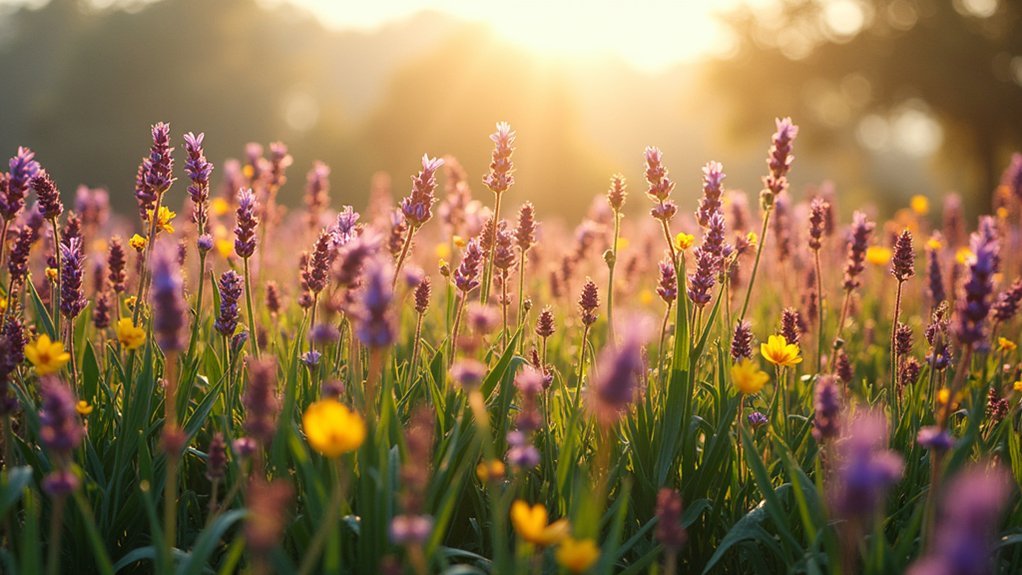
While many homeowners choose living fences for their aesthetic appeal, the timing of when these natural barriers bloom follows complex scientific principles. Your living fence’s flowering schedule depends primarily on environmental triggers like temperature fluctuations, day length, and moisture availability.
Many hedge species require vernalization—a period of winter cold—before they’ll produce flowers in spring. You’ll notice photoperiodism at work when certain shrubs bloom only after day length reaches specific thresholds.
The soil quality around your fence line greatly impacts nutrient availability, directly affecting bloom timing. Grouping similar hedge plants in threes to fives creates a more unified and visually appealing natural fence line.
Your pruning practices can dramatically alter flowering patterns too. Cut back spring-flowering shrubs immediately after blooming to avoid removing next year’s buds.
For summer bloomers, winter pruning encourages more vigorous flowering when warmer weather arrives.
Seasonal Cycles of Popular Natural Fence Plants
The practical application of bloom timing principles becomes most apparent when examining specific fence plants’ yearly cycles. You’ll notice distinct patterns among popular choices for living barriers, each with unique seasonal characteristics.
| Plant | Primary Bloom Season | Key Characteristics |
|---|---|---|
| Encore Azaleas | Spring + Summer/Fall | Continuous color for 6+ months with multiple cycles |
| Waxleaf Privet | Spring (Zones 7-11) | Fragrant white flowers; excellent heat tolerance |
| Bridal Wreath Spirea | Late Spring | Shifts from leaf emergence to white/pink blooms |
| Climbing Roses | Summer | Timing sensitive to day length; requires careful pruning |
| Abelia | Summer | Salt-tolerant; provides texture after flowering |
Climate greatly impacts performance—hollyhocks struggle in humid southern regions, while coastal properties benefit from salt-tolerant species like abelia. Proper pruning timing directly affects bloom cycles, with spireas requiring immediate post-bloom trimming to encourage additional flowering. Among evergreen options, Emerald Green Arborvitae maintains year-round privacy without prominent bloom cycles, focusing instead on consistent foliage.
Achieving Year-Round Color With Strategic Plant Selection
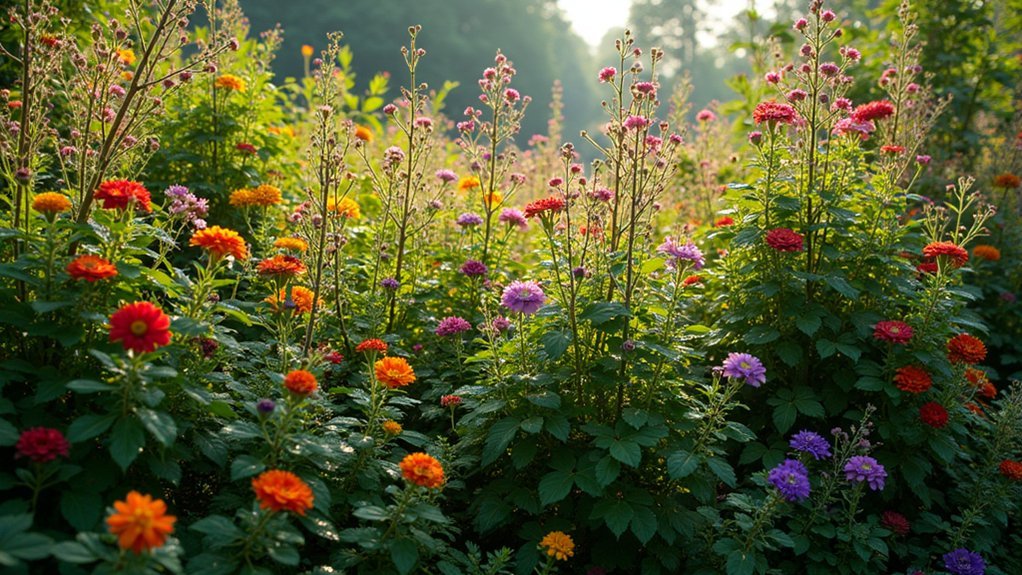
You’ll transform your natural fence into a year-round showcase by combining evergreens like boxwood with seasonal bloomers such as hydrangea and witch hazel.
Strategic plant groupings allow for succession blooming where spring lilacs give way to summer hydrangeas and fall viburnums, creating continuous visual interest.
Your fence can maintain its appeal through all seasons when you pair plants with complementary bloom cycles and contrasting textures like the smooth boxwood alongside prickly junipers.
Consider including the North Pole Arborvitae as it provides a consistent vertical element reaching heights of about 10 feet with dense evergreen foliage.
Seasonal Planting Combinations
Creating year-round visual interest with natural fences requires thoughtful combinations of plants that shine in different seasons.
By balancing evergreens with deciduous varieties, you’ll enjoy continuous beauty with minimal maintenance.
For a dynamic fence border throughout the year, consider these seasonal combinations:
- Spring: Pair climbing roses with western redbud for vibrant early color, while English ivy provides a consistent green backdrop. Incorporating native plants will ensure better adaptability to local conditions while supporting local wildlife ecosystems.
- Summer: Integrate wisteria vines with ornamental grasses to add both movement and flowering interest.
- Fall: Combine purple hopseed and Oregon grape for stunning burgundy foliage and colorful berries that attract birds.
- Winter: Incorporate holly shrubs and broadleaf evergreens to maintain structure and visual appeal during colder months.
Succession Bloom Design
Strategic succession bloom design transforms ordinary natural fences into living tapestries of color that evolve throughout the year.
By selecting plants with staggered flowering periods, you’ll create a fence that’s never without visual interest.
Begin with early bloomers that establish quickly and provide the first flush of color. Follow with mid-season perennials and shrubs that take center stage as early bloomers fade. Complete your design with late-season species that extend the show into fall.
Layer your plantings vertically—groundcovers beneath mid-height perennials topped by taller shrubs—to maximize space and bloom potential. This mimics natural plant communities where species have evolved to flower when conditions favor their reproduction.
Your natural fence won’t just look beautiful; it’ll support local pollinators and wildlife with continuous food sources and habitat. Including species like rugosa rose and wild black raspberry enhances both the aesthetics and ecological value by creating a thorny barrier that offers protection.
How Climate Zones Determine Your Fence’s Flowering Schedule
Your fence’s flowering schedule directly depends on your USDA hardiness zone, which determines which plants will survive winter temperatures and when they’ll bloom each year.
Even within your official climate zone, small microclimates created by walls, slopes, or wind patterns can shift flowering times by up to two weeks.
Understanding these zone limitations and microclimate effects lets you choose plants that will flourish in your specific conditions rather than struggling against nature’s constraints. Plants like forsythia may display different blooming patterns based on available snow cover protection, with buds below snow surviving harsh temperatures while those exposed often perish.
Hardiness Zone Limitations
Nature’s calendar operates differently across geographic boundaries, and flowering schedules follow suit. While hardiness zones help predict which plants will survive winter temperatures in your area, they don’t tell the complete story of flowering success.
Your natural fence’s blooming potential faces several key limitations:
- Cold focus only – Traditional zones measure minimum temperatures but overlook heat stress that can diminish blooms.
- Moisture blindness – Zones don’t account for drought or humidity factors that greatly impact flowering.
- Genetic variation – Plants sourced from warmer regions may bloom unreliably when planted in cooler zones.
- Climate shifts – Changing weather patterns mean your zone’s historical data may become less reliable for predicting bloom times. The 2023 USDA map reveals that half of the United States has shifted to a warmer subzone since 2012.
Understanding these limitations helps you make smarter choices for a consistently flowering fence.
Microclimates Matter
While hardiness zones provide a broad framework, the real magic happens in the smaller pockets of climate within your property. These microclimates greatly impact when and how your natural fences bloom.
Your south-facing fences absorb more sunlight, creating warmer areas that extend the growing season and prompt earlier flowering. Meanwhile, north-facing or shaded sections maintain cooler, moister conditions that delay blooms.
Wind exposure plays an essential role too. Plants sheltered from harsh winds flower more vigorously, while those in turbulent areas struggle. Wind corridors between buildings or structures can create turbulent air flow that damages delicate flowers and stunts growth on your living fence.
The material of your fence also matters—heat-absorbing materials radiate warmth at night, protecting plants from frost and accelerating flowering cycles.
Nearby structures and vegetation further modify these conditions. Trees, buildings, and slopes all influence air movement, soil moisture, and temperature variations that directly affect your fence’s blooming patterns.
Sunlight Exposure and Its Impact on Bloom Patterns
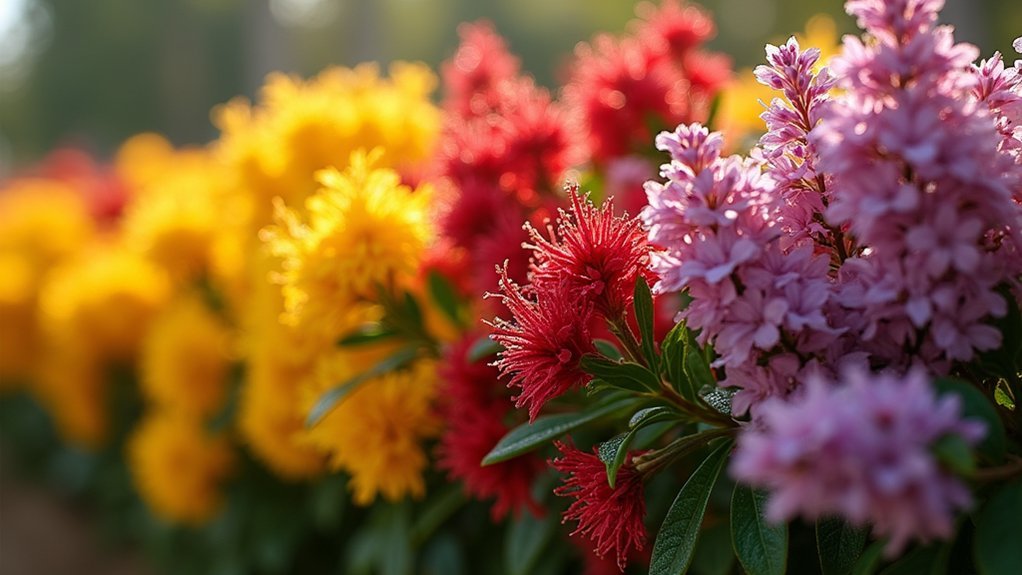
Understanding sunlight exposure is essential when designing natural fences that optimize bloom patterns. Your fence’s orientation dramatically affects how plants receive light, with north-south positioning providing the most balanced exposure throughout the day.
Consider these key factors for maximizing blooms:
- Sun intensity – Plants receiving more than six hours of direct sunlight often produce more vibrant flowers but need additional watering.
- Fence materials – Dark-colored materials absorb heat, creating warmer micro-environments that can extend blooming periods.
- Strategic placement – Creating U-shaped designs or sun traps on your fence’s north side maximizes sunlight capture while protecting blooms from wind. Creating a detailed sun map by taking hourly photos throughout the day can help identify optimal locations for different plant varieties.
- Seasonal shifts – Anticipate how changing sun angles will affect your fence throughout the year, especially for spring and summer flowering varieties.
Soil Chemistry: The Hidden Factor in Fence Flowering
Beneath the vibrant blooms adorning your natural fence lies an invisible influence that considerably shapes flowering patterns: soil chemistry. The nutrient profile of your soil—particularly nitrogen and phosphorus levels—directly impacts which plants thrive and how abundantly they flower.
You’ll notice more diverse blooming in areas with balanced pH and nutrient-rich soils. These conditions create positive feedback loops where plants modify their microenvironments, influencing subsequent growth. Annual haying tends to reduce soil nitrogen, which may favor forbs over grasses along fence lines.
Even micronutrients like iron affect flowering by strengthening plant defenses against herbivores.
When soil fertility varies along your fence line, it creates microhabitats supporting different plant communities. These variations explain why one section might showcase vibrant blooms while another remains sparse.
Pruning Strategies to Maximize Bloom Duration
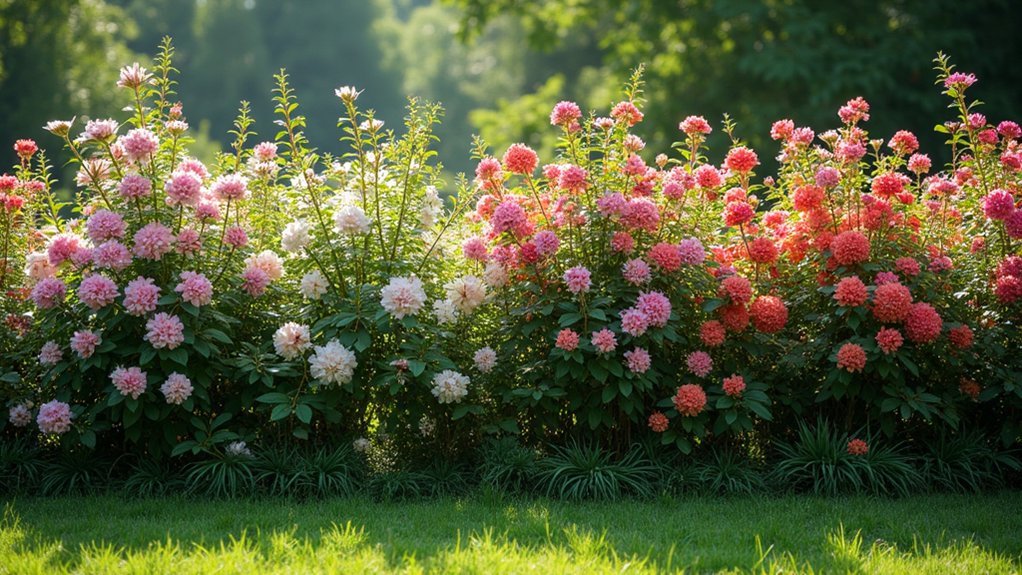
Proper pruning stands as the unsung hero in extending the spectacular bloom display of your natural fence. By timing your cuts strategically after flowering, you’ll avoid accidentally removing next year’s flower buds while encouraging robust new growth.
Precise pruning transforms an ordinary fence into a perpetual flower showcase while protecting future blooms.
For maximum blooming potential, follow these key strategies:
- Use thinning cuts to remove select branches, allowing sunlight to penetrate and stimulate flowering throughout the fence.
- Practice tip pruning on shoot ends to promote branching and create a fuller, more flower-rich appearance.
- Time your pruning right after blooming for spring-flowering shrubs, preventing the removal of next season’s buds.
- Disinfect your tools between cuts to prevent disease spread that can diminish flowering potential.
Consider incorporating native species into your living fence design for enhanced biodiversity and more reliable blooming patterns.
Weather Patterns and Their Effect on Natural Fence Displays
Your natural fence’s blooming schedule shifts dramatically with each 1°C temperature increase, typically advancing flowering by 2-5 days across species.
You’ll notice rainfall patterns create divergent responses—with drought-stressed moisture-sensitive plants delaying blooms while drought-adapted varieties flower earlier.
The microclimates around your property can trigger up to three weeks difference in bloom times between sunny exposures and shaded areas, allowing you to strategically position plants for extended seasonal displays.
Research shows that late-blooming species typically exhibit longer flowering periods when conditions are wetter, giving you more visual impact during autumn months.
Seasonal Temperature Fluctuations
As temperatures rise and fall throughout the year, natural fences respond in ways that dramatically affect both their appearance and structural integrity.
Your living fence materials expand and contract with these changes, potentially compromising their durability if not properly prepared for local climate conditions.
To maintain your natural fence through temperature fluctuations:
- Select climate-appropriate plants that thrive in your specific hardiness zone
- Apply protective sealants before winter to shield wooden elements from freeze-thaw damage
- Space boards properly to allow for natural expansion during warmer months
- Consider microclimates around your property that might affect different sections of your fence
Wood fences are particularly vulnerable to drying out in heat and cracking in cold, while even minor temperature variations can greatly impact flowering patterns and growth rates in living fence plants. Using UV-resistant coatings on wooden components can significantly extend their lifespan against degradation caused by intense sun exposure.
Rainfall’s Flowering Impact
While temperature fluctuations greatly affect fence structure, rainfall patterns fundamentally determine when and how vibrantly your living fence will bloom. You’ll notice earlier flowering in fertilized plants with adequate rainfall, particularly in goldenrod which may bloom up to 18 days earlier. Experimental research demonstrates that fertilizer and rainfall variations can alter plant bloom time by up to 218 days, showing the significant impact of environmental conditions.
| Rainfall Level | Goldenrod Response | Sunflower Response |
|---|---|---|
| Drought | Earlier senescence | Shortened bloom window |
| Moderate | Extended blooming | Consistent flowering |
| Heavy | Lush growth | Synchronized flower pulses |
During drought years, your living fence will produce shorter bloom periods, while exceptionally wet seasons extend growth phases but sometimes delay flowering. Native species adapt better to your region’s rainfall variability than non-natives. Consider planting along contours—this reduces erosion, stabilizes blooming cycles, and prevents nutrient runoff that supports sustained flowering.
Sunlight Duration Effects
The daily ebb and flow of sunlight fundamentally shapes when and how vibrantly your living fence will display its blooms. Your fence plants respond to both the intensity and duration of light they receive, with some species requiring specific day-length conditions to trigger flowering. Different sections of your fence may experience varying sunlight intensity depending on the time of day and season.
Understanding these light-dependent behaviors helps you predict and even manipulate bloom times:
- Long-day plants like roses and clematis flower when daylight exceeds 12 hours, making them spring and summer bloomers.
- Short-day plants such as chrysanthemums bloom when nights grow longer in fall.
- Day-neutral plants like sunflowers respond primarily to maturity rather than day length.
- Microclimates within your fence line create varied light conditions, explaining why identical plants may bloom at different times.
Native vs. Exotic Species: Comparing Bloom Reliability
Gardeners often face a crucial decision when establishing natural fences: whether to rely on native plants with their evolutionary-tuned bloom cycles or exotic species with their extended flowering periods.
Native plants offer predictable, reliable blooming that synchronizes perfectly with local pollinators’ life cycles, creating a sustainable ecosystem in your garden fence.
You’ll notice they’re naturally adapted to local conditions and resist regional pests without intervention.
In contrast, exotic species can provide longer, sometimes more spectacular blooming periods, especially in late summer when native blooms may wane.
However, they might disrupt local pollination patterns and potentially become invasive by outcompeting native vegetation.
Your choice affects not just aesthetics but biodiversity too—native plantings generally support higher levels of local wildlife while contributing to ecosystem stability and resilience.
Creating Complementary Bloom Sequences in Mixed Fences
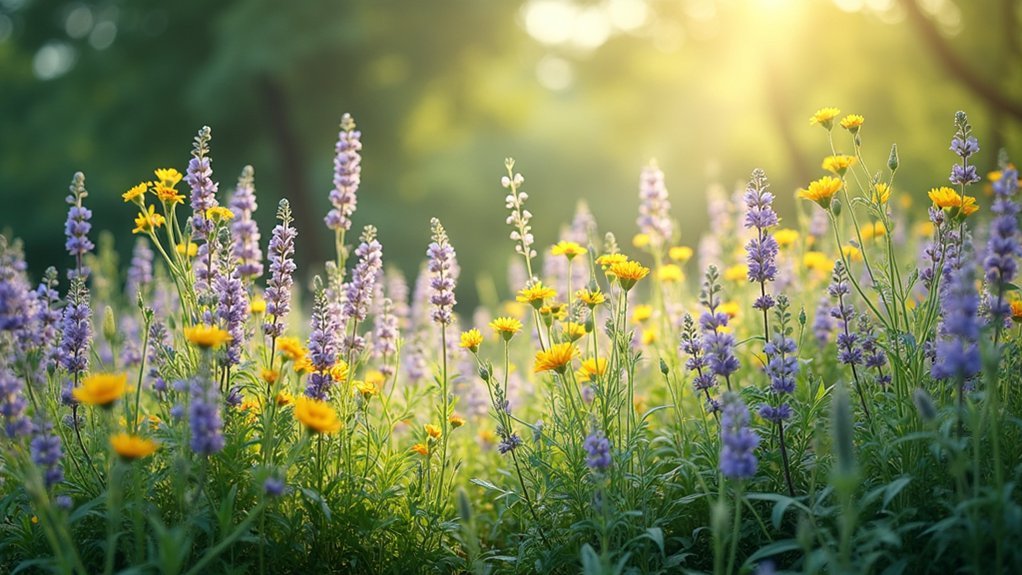
Creating a mixed fence with complementary bloom sequences transforms your garden boundary from a simple divider into a dynamic, living tapestry that evolves throughout the year.
By strategically selecting plants with staggered flowering periods, you’ll enjoy continuous visual interest from early spring through winter.
To design your own complementary bloom sequence:
- Start with seasonal anchors – Plant early bloomers like snowdrops alongside winter-flowering hellebores and fall-blooming asters.
- Layer by height – Position taller plants toward the back, creating depth and allowing all blooms to be visible.
- Harmonize colors – Use complementary pairings like blue and orange or create soothing monochromatic themes.
- Include evergreen elements – Incorporate shrubs with attractive foliage to maintain interest during dormant periods.
The Relationship Between Growth Habits and Flowering Potential
Understanding the intricate relationship between a plant’s growth habit and its flowering potential helps you create more effective natural fences.
Plants with dense foliage, while providing excellent privacy, often bloom less frequently because they direct energy toward leaf production rather than flowers.
You’ll notice that fast-growing species typically produce fewer blooms as they prioritize vegetative growth over reproduction.
In contrast, plants like bougainvillea that receive full sun will reward you with frequent, vibrant blooms throughout the year.
Regular pruning encourages flowering by redirecting energy to bloom production instead of excessive growth.
When selecting fence plants, consider that evergreens offer year-round coverage but usually have limited flowering periods compared to deciduous varieties.
Species like dogwoods and viburnums have distinct blooming seasons that you can strategically incorporate for continuous visual interest.
Attracting Seasonal Pollinators With Timed Blooming Cycles
When you establish a natural fence with strategically timed blooming cycles, you’ll transform your property boundary into a vibrant pollinator highway.
By incorporating plants that bloom throughout different seasons, you’re creating a continuous food source for bees, butterflies, and birds.
To maximize pollinator attraction in your living fence:
- Include early bloomers like hawthorn for spring nectar when other sources are scarce.
- Layer mid-height plants such as elderberry with taller sunflowers for summer sustenance.
- Add autumn-flowering species to support pollinators preparing for winter.
- Mix native plants with naturalized species like Siberian pea-shrub to enhance biodiversity.
This meadowscaping approach not only supports local wildlife but also creates a dynamic boundary that changes with the seasons, displaying different colors and textures throughout the year.
Frequently Asked Questions
How Do Natural Fences Affect Property Values Compared to Conventional Fencing?
Natural fences can enhance property values through aesthetic appeal but may reduce value if poorly maintained. You’ll generally see more consistent value increases with conventional fencing due to its reliability, security, and lower maintenance requirements.
Can Natural Fences Provide Security Benefits Similar to Traditional Fencing Materials?
Yes, your natural fence can provide comparable security benefits through thorny species, dense growth patterns, and height advantages. They create physical barriers, reduce visibility, generate noise alerts, and offer psychological deterrents to potential intruders.
How Do Living Fences Impact Noise Pollution in Residential Areas?
Living fences absorb and deflect sound waves effectively. You’ll find they create multiple layers of density through foliage and branches. They’re especially effective when you plant dense shrubs or hedges alongside traditional fencing materials.
Are There Natural Fence Options Suitable for Allergy Sufferers?
Yes, you’ll find several allergy-friendly natural fence options. Choose female cultivars, double-flowered varieties, or non-flowering plants like boxwood. Avoid high-pollen producers such as juniper, cypress, and privet for your barrier.
How Do Natural Fences Perform During Extreme Weather Events?
Natural fences vary in extreme weather performance. You’ll find bamboo bends in wind but may break in storms. Living hedges generally withstand rain and snow well, but they’re not as reliable as composite or metal alternatives.
In Summary
Your living fence’s blooming patterns depend on countless factors—from your climate zone to sunlight exposure. By understanding each plant’s natural cycle, you’ll create a dynamic boundary that flowers sequentially throughout the year. Don’t hesitate to mix native and exotic species for reliable color. You’re not just building a fence—you’re orchestrating a living symphony that attracts pollinators while serving your practical needs.

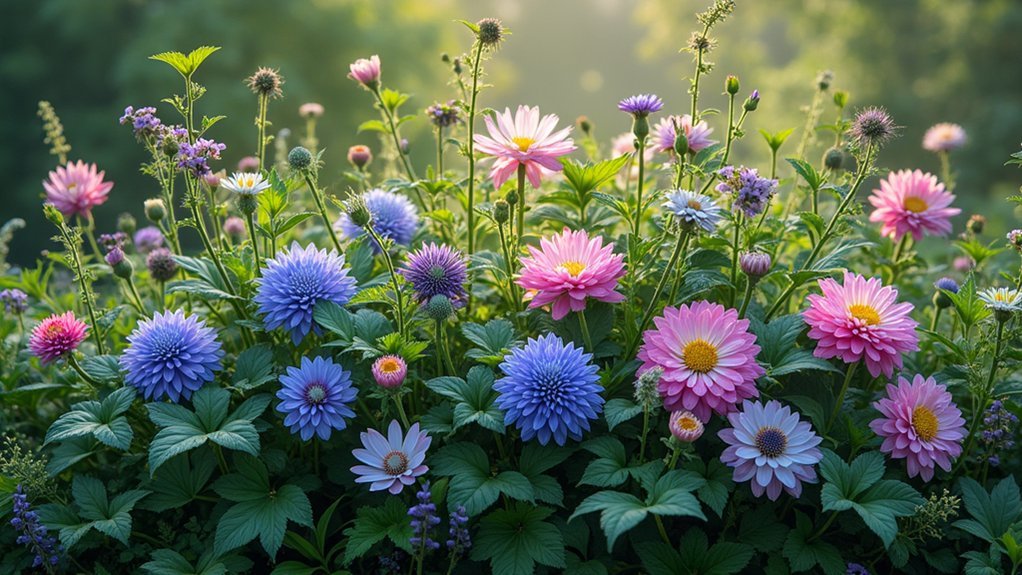



Leave a Reply